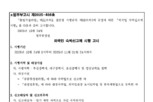
What is the difference between "sell by" date and "use by" date?
Sell by date means the final time that can be sold to consumers after the date of manufacture of the product. This means that properly stored and managed food can be eaten with confidence by consumers, and the manufacturer is responsible for the quality or stability of the product.
The sell by date is set to be 60-70% ahead of the time of change in food quality, so if you keep the storage conditions well, you can eat longer.
The sell by date was introduced in 1985 as the final deadline for the distributor to sell food and other products to consumers.
The use by date is the deadline for consumers to consume food. It refers to the final deadline for consumption, which is recognized as safe and healthy for consumers if they consume the product.
The use by date is set according to the results of the microbial decay change test when conditions are met based on the use by date.
What are the pros and cons of changing the expiration date to "use by" date?
The "Use by Date" indication system takes effect on January 1, 2023. The introduction of the use by date marking system is expected to benefit the economy and the environment.
Experts predict that when the use by date is introduced, the period of food intake will increase by 30% compared to the sell by date.
Even though the use by date remains, foods that were discarded due to the sell by expiration date will be reduced, which will help the environment, and social costs incurred in food disposal can be reduced. In addition, it is a food system that meets international standards and helps export domestic food abroad.
It is right to dispose of food that has passed the use by date because it is the maximum period to consume food when it is properly distributed and stored.
In order to keep food safe, you must be familiar with the storage method of each food, and maintain 0 to 10 degrees in refrigeration, below minus 18 degrees in freezing, and 1 to 35 degrees in room temperature.
(한국어 번역)
한국다문화뉴스=강성혁 기자ㅣ유통기한과 소비기한의 차이점은?
유통기한이란, 제품의 제조일로부터 소비자에게 제품을 판매할 수 있는 최종 기한을 의미합니다. 기간 내에 적정하게 보관하고 관리된 식품은 소비자가 안심하고 먹을 수 있으며 제조업체는 제품의 품질이나 안정성을 책임진다는 뜻입니다.
유통기한은 식품의 품질변화 시점을 기준으로 60~70%까지 앞선 기간으로 설정되기 때문에 보관 조건을 잘 지켰다면 더 오래 먹을 수 있습니다.
유통기한은 유통업체 입장에서 식품 등의 제품을 소비자에게 판매하되 되는 최종 시한으로 1985년 도입되었습니다.
소비기한이란 소비자가 식품을 소비할 수 있는 기한을 말합니다. 해당 상품을 소비해도 소비자의 건강이나 안전에 이상이 없을 것으로 인정되는 소비의 최종 기한을 의미합니다.
소비기한을 기준으로 조건을 지켰을 때의 미생물 부패 변화 검사 결과에 따라 소비기한이 설정됩니다.
소비기한으로 변경 시 장단점은?
"소비기한" 표시제는 2023년 1월 1일부터 시행되는 제도입니다. 소비기한 표시제가 도입되면 경제적 이익과 환경에 도움이 될것으로 기대가 됩니다.
전문가들은 소비기한 도입 시 음식물 섭취 가능 기간이 유통기한과 비교해 30% 정도는 늘어날 것으로 예상하고 있습니다.
소비기한이 남아있음에도 유통기한이 지났다는 이유로 폐기되던 음식물이 줄어들어 환경에 도움이 될 것이며, 음식물 폐기 시 발생하는 사회적 비용을 줄일 수 있게 됩니다. 또 국제 기준에 맞는 식품 제도로 국내 식품 해외 수출에도 도움이 됩니다.
소비기한 식품을 올바르게 유통, 보관했을 때 식품을 섭취할 수 있는 최대한의 기한이기 때문에 소비기한이 지난 식품은 폐기하는 것이 옳습니다.
식품을 안전하게 유지하기 위해서는 반드시 식품별 보관방법을 숙지해야 하며 냉장기준 0~10도 냉동기준 영하 18도 이하, 실온기준 1~35도를 유지해야 합니다.





















